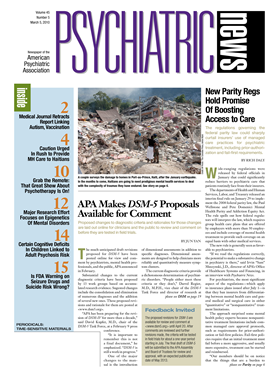Last month, APA posted the
DSM-5 draft criteria on the
DSM-5 Web site and held a variety of press and advocacy-group briefings about the launching (see
APA Makes DSM-5 Proposals Available for Comment). The resulting coverage has been generally positive, although there will continue to be naysayers and those who want to emphasize the controversies rather than the science and great efforts than have been extended thus far.
I want to acknowledge the leadership of the DSM-5 Task Force and the overall development process chaired by my friend and colleague, Dr. David Kupfer from the University of Pittsburgh; Dr. Darrel Regier from the American Psychiatric Institute for Research and Education (APIRE), the vice chair of the task force; and Dr. William Narrow, also from APIRE, the director of research for DSM-5; as well as the many staff who have assisted them. I also wish to thank the 160 scientists and clinicians—members of the various task forces, study groups, and work groups—who have contributed immense knowledge and time without compensation. Also deserving recognition are the 400 international scientists who participated in a series of NIH-funded preparatory conferences that articulated a number of key issues that have informed the DSM-5 efforts, even prior to the deliberations of the work groups. We are indebted to these individuals.
I have not been personally involved in the DSM-5 deliberations, and when I went on its Web site last week, I was impressed by how much work has been accomplished.
In spite of some critics' decrying a lack of progress in the field and the lack of a need for DSM-5, much research and clinical experience have informed the proposed changes, and I believe these changes will help patients and clinicians. One example has been the controversy regarding the rapidly increasing rates of bipolar diagnoses in children. The rise has stemmed, in part, from the way some investigators have applied current diagnostic criteria, particularly substituting irritability for elation when the usual episodic nature of bipolar disorder is absent. One proposed diagnosis for DSM-5 is a temper dysregulation disorder and the re-emphasis on severity of impairment for receiving a diagnosis. Recent research has indicated that these children are at low risk for developing adult bipolar disorder; rather, as they grow up, they have depression, anxiety, and/or intermittent explosive disorder.
Other examples are the proposed reorganization of the autism category into a spectrum of disorders and the consolidation of the personality disorders and moving them to Axis I. Similarly, the multiple schizophrenia diagnoses have been collapsed into one category, and substance abuse/dependence have been merged into single addictive disorder categories. These changes will result in a reduction of the number of disparate syndromes in our specialty.
One of the key differences between DSM-IV and DSM-5 (yes, we are now using the Arabic number system to allow for ongoing brief updates as the science progresses) is a greater attempt to define the thresholds for severity and provide greater specificity to the DSM-IV clinical significance criteria of distress or impairment that need to be met to make a diagnosis.
This approach should obviate attacks that we are finding and expanding the rubric of psychopathology and rein in problems that occur when some apply the criteria to sampling populations. The thresholds are key with all the diagnoses, particularly for several of the risk syndromes being proposed for psychotic disorders and potential dementias. The minor neurocognitive impairment diagnosis follows the efforts in neurology to address mild cognitive impairment that is often a predecessor of Alzheimer's disease and that prompts patients to seek evaluation and treatment from neurologists and memory clinics. Perhaps more controversial is the psychosis risk syndrome to address decompensating patients who may go on to a full episode/diagnosis of schizophrenia. To receive the risk diagnosis, the patient must be experiencing hallucinations or delusions and must be seeking treatment. Although psychosocial interventions may be most effective at present, some would argue that syndromes will drive medication prescriptions, but that argument may reflect more stigma and antipsychiatry sentiment than reality. For example, prodromal psychosis could be treated by cognitive-behavioral therapy or dietary supplements (as was described in a recent paper on omega-3 fatty acids). For mild neurocognitive impairment, lipid-lowering strategies—both somatic and psychosocial/behavioral (for example, diet and exercise)—may be helpful.
Last, another proposal is to apply the Patient Reported Outcomes Measurement Information Systems (PROMIS) measures of anxiety and depression as dimensions across disorders. These scales have been developed by NIH to assess anxiety and depression associated with medical disorders. In addition, there is a proposal to assess suicidality and substance abuse as well as other symptom domain dimensions. These should help paint a fuller picture of a patient's pathology. And they will position us to assess the relationship of symptoms to genetic variation and brain-imaging alterations.
The next steps in the DSM process are to gather the responses from our members and the professional and lay public and determine whether any of the proposed changes need to be amended before the field trials begin in the summer.
The
DSM-5 Web site can be found at <
www.dsm5.org>. After registering, anyone can access this very informative, user-friendly site. I invite you to log on, review, and comment on the proposed changes.


